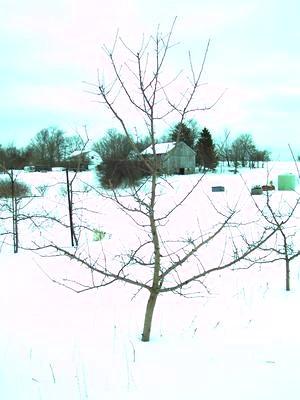Pruning Is a Balance of Art and Science

This well balanced apple tree will produce good quality, large fruit next year.
Grandpa has received lots of questions about pruning over the years. Unfortunately, there really is no hard and fast scientific formula for pruning. We have found that most backyard orchardists prune too little. And a small few prune too much. Many just prune because they think they have to every year with their goal to just make the tree look pretty. But pruning is more than just cutting off limbs to make the tree look pretty. It is as much an art, as it is a science.
Late winter is a good time to dormant prune apples and pears, but one should wait until early spring to prune stone fruits. Depending on where you live in the country, you should be considering doing some kind of dormant pruning on fruit trees pretty soon. Don’t wait until the leaves are out and the trees are growing.
Many a horticulture professor has tried to make pruning into a “science”. Grandpa has seen some really smart ones do some “hatchet” jobs in order to get that picture perfect tree they think we need to strive for, but he’s also seen other more practical professors take a more balanced approach to pruning.
In Grandpa’s experience and philosophy, the key is “balance”. Proper pruning has several objectives:
- to reduce potential fruit load and thus increase fruit size
- to improve light penetration into the tree and help improve fruit quality
- to train the tree to meet certain growth habit and structural goals
- to remove “old” wood and renew younger, better fruiting wood
- to maintain vigor at an appropriate level.
If you fail to prune every year, you cannot reach these goals. Underpruning, or not pruning at all, will result in low vigor, too much fruit, poor quality fruit, and an “ugly” tree. Over pruning also puts your tree out of balance with excessive regrowth, poor light penetration and poor fruit quality. Maintaining proper vigor is one of the most important goals of “dormant” pruning. Dormant pruning should only be done when the tree has fully gone to sleep, is properly hardened off for the winter, and hopefully before it starts to break dormancy very much. A little bud break is OK, but active shoot growth when the shoots have elongated and leaves are forming, means that you are well out of the “dormant” season.
Tree vigor is controlled by the amount of nutrients available each year. These nutrients come from applying fertilizers as well as utilizing the stored nutrients and energy in the root system from the prior year. Heavy pruning during the dormant season leaves less growing points (buds) to feed on the tree, and thus more growth can be expected from each growing point. Lighter pruning will leave more potential growing points and thus less energy available for each one, resulting in weaker growth. So, it is easy to understand why it is important to maintain a balance between the proper amount of fertilizer application each year and the proper amount of dormant pruning.
“Summer” pruning, or pruning when the tree is actively growing after the spring growth push, from summer and into the early fall, actually is a “de-vigorating” action. It removes growth and nutrients from the tree and does not allow the tree to recover those nutrients into the root system in the fall for use the following year. If you do need to Summer prune, it must be done very judiciously as there can be some unexpected results that can hurt the tree. Summer pruning should only be used when you have very excessive, very vigorous growth caused by over-pruning or over-fertilizing. Ask for some advice before you do much summer pruning. Timing and amount are critical.
How much growth is too much or too little? There is no set rule, but as a guideline, Grandpa likes to see
- 12-24 inches of new, terminal, annual growth on apples and pears. Towards the 12″ side for full dwarf trees, and toward the 24″ side on semi-standard trees.
- for peaches, nectarines, plums, prunes, and apricots — 18-30″ is a good range.
- for sweet and tart cherries on standard, dwarfing and Gisela® rootstocks aim for 12-18″.
Don’t get too excited if you over- or under- prune/fertilize any one year. It takes time to gain experience and a technique that work for you. Look at the results from what you have been doing, and make adjustments the next year. Fruit trees are sturdy and resilient plants and pruning mistakes hardly ever kill trees (well, except when summer pruning incorrectly!). Remember, pruning is both “art” and “science”, so you will learn to develop your own style that works for you. Who else really cares!